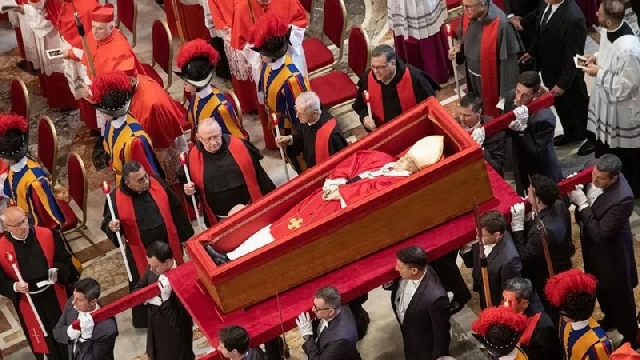Pope Francis funeral sets for Saturday
 Pope sets for burial on Saturday
Pope sets for burial on Saturday
The funeral of Pope Francis will take place on Saturday, in front of St Peter's Basilica in Vatican City.
Preparations have begun for the conclave, the process by which cardinals will elect the next Pope.
What will happen at the Pope's funeral?
The Pope's body is lying in state inside St Peter's Basilica.
Thousands of mourners have queued to say a final goodbye before his funeral takes place on Saturday, at 10:00 local time (09:00 BST).
Papal funerals have historically been very elaborate, but the instructions set out by Francis are much simpler.
He will be the first Pope in more than a century not to be buried inside the Vatican. Instead, he will be laid to rest in Rome's Basilica of St Mary Major.
Francis asked to be buried in a simple wooden casket lined with zinc - unlike his predecessors, who were buried in three nesting coffins made of cypress, lead and oak.
The service will be led by Cardinal Giovanni Battista Re, dean of the College of Cardinals. Patriarchs, cardinals, archbishops, bishops, and priests from across the globe will also take part.
After a concluding prayer formally entrusting the Pope to God, the pontiff's body will be moved to St Mary Major for the burial.
A nine-day mourning period, known as Novemdiales, will then begin.
Dozens of world leaders and thousands of worshippers will attend the funeral.
UK Prime Minister Sir Keir Starmer, US President Donald Trump, Ukrainian President Volodymyr Zelensky, and French President Emmanuel Macron have said they will attend, as has Javier Milei, the president of Argentina, Francis's home country. The Prince of Wales will represent King Charles.
Who is in charge after the Pope dies?
Pope Francis died on Easter Monday aged 88, following a stroke and subsequent irreversible heart failure.
The death was confirmed and announced by the Pope's "camerlengo", or chamberlain - currently Irish-American cardinal Kevin Farrell.
The camerlengo manages the various procedures and rites which follow the death of a Pope.
As part of this, Cardinal Farrell locked and sealed the Pope's home, and destroyed the Pope's ring and lead seal, which is used to authenticate official documents.
The camerlengo also organises the conclave to elect the new pope.
They can become pope, but this has only happened twice: Gioacchino Pecci (Pope Leo XIII) in 1878 and Eugenio Pacelli (Pope Pius XII) in 1939.
How is a new Pope chosen?
The new Pope is elected by the cardinals - all men who were appointed by the Pope and are usually ordained bishops.
There are currently 252 Catholic cardinals, but only 135 can cast ballots as those over the age of 80 can take part in debate but cannot vote.
Traditionally the conclave doesn't start until after a 15-day mourning period.
However, in 2013, Francis's predecessor Benedict changed the rules to allow it to begin earlier if the cardinals wished.
How does the conclave work?
During the voting period, the cardinals are cut off from the outside world – denied phones and access to the internet or newspapers.
They sleep in Casa Santa Marta, a five-story guesthouse within the Vatican complex.
The election is held in strict secrecy inside the Sistine Chapel, famously painted by Michelangelo.
Each cardinal votes for the candidate they wish to become Pope. They can vote for themselves if they wish.
A new Pope is elected when a candidate has secured the support of 90 cardinals - which can take several rounds of voting.
In previous centuries, conclaves have gone on for weeks or months. Some cardinals have even died during the process.
How is smoke used to announce the new Pope?
To the outside world, the only information about how the conclave is progressing is smoke from the chapel's chimney when ballot papers are burned after each round of voting.
Black smoke signals failure. White smoke means a new Pope has been chosen.
The new Pope normally appears on the balcony overlooking St Peter's Square within an hour of his selection.
The senior cardinal confirms the decision with the words "Habemus Papam" - Latin for "we have a Pope" - and introduces the new pontiff by his chosen papal name.
For example, Pope Francis was born Jorge Mario Bergoglio, but chose his papal name to honour St Francis of Assisi.
Who can become Pope?
In theory, any Roman Catholic man who has been baptised can be considered.
In practice, however, the cardinals prefer to select one of their own.
In 2013, Francis became the first pontiff to hail from Latin America - a region that accounts for around 28% of the world's Catholics - and the southern hemisphere.
Historical precedent suggests the cardinals are far more likely to pick a European. Of the 266 popes chosen to date, 217 have been from Italy.
Several Vatican analysts have suggested Francis's successor could come from outside Europe - not least because the late Pope appointed more than 140 cardinals from beyond the continent.
What does the Pope do?
The Pope is the head of the Catholic Church, and is an important source of authority for the world's roughly 1.4 billion Roman Catholics.
They believe the Pope represents a direct line back to Jesus Christ. He is considered a living successor to St Peter, who was chief among Christ's initial disciples, the Apostles.
About half of all Christians worldwide are Roman Catholics. Other denominations, including Protestants and Orthodox Christians, do not recognise the Pope's authority.
The Pope lives in Vatican City, the smallest independent state in the world. It is surrounded by the Italian capital, Rome.
The Pope does not receive a salary, but all his travel costs and living expenses are paid for by the Vatican.
Source: BBC
Trending World

UK's highest court rules that the law defines a woman as someone born biologically female
16:38
Death every 3 minutes: Why India's roads are among the world's deadliest
01:41
Vatican announces death of Pope Francis aged 88
15:41
Who will be the next pope? Key candidates in an unpredictable process
13:45
Pope Francis funeral sets for Saturday
05:08




